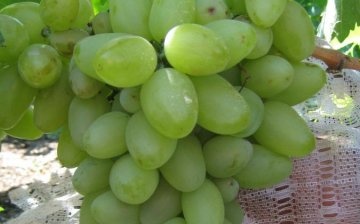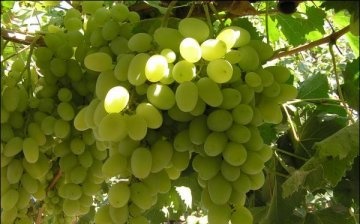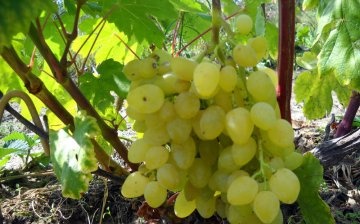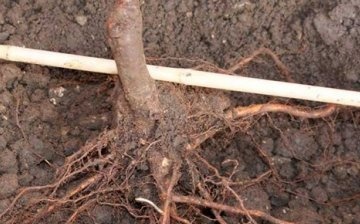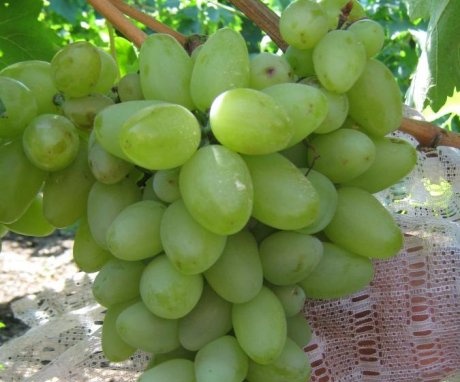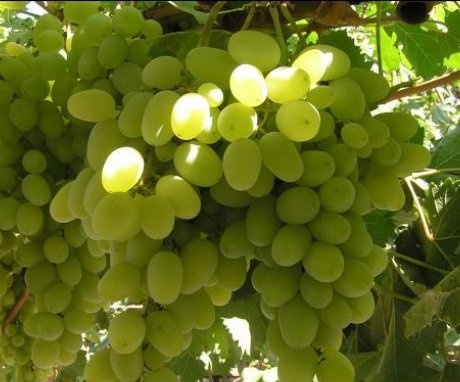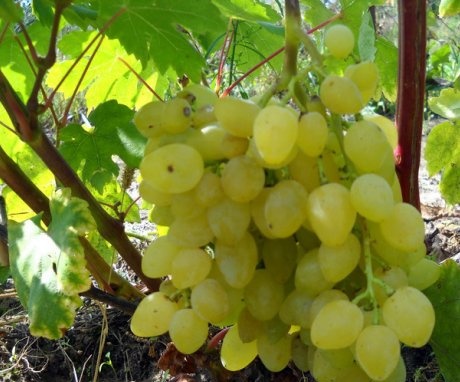Bazhena grapes: features of the variety, cultivation and proper care for a good harvest
Bazhena grapes were bred by V.V. Zagorulko. He bred two varieties: "Gift to Zaporozhye" and "Arcadia". The resulting hybrid turned out to be very successful. Delicious, fruitful, early.
Content:
- Characteristics of the Bazhena grape variety
- Secrets of growing grapes
- The subtleties of caring for grapes
Characteristics of the Bazhena grape variety
External parameters of bazhena grapes:
- The shape of the berries and the taste are reminiscent of Arcadia. But the size of the berry is 2 times larger, they are found up to 6 cm. The weight of one varies from 14 to 23 grams. The color range is from yellowish to bright light green. The shape of the berry is not correct, closer to oval.
- The size of the bunches is large... Bunches of irregular shape, closer to the cone. The density of the grapes in a bunch is average. The bunch weighs about 1000 mg. Especially large ones can reach 2 kg.
- The grape bushes are lush, the leaves are medium, bright green.
- Berries are resistant to cracking. Thanks to this, the grapes retain their presentable appearance well during changes in the weather.
- Bazhena grapes are resistant to frost up to 22-24 degrees. But it is imperative to cover it in winter to prevent freezing.
- It has a very delicate and thin skin. It is almost imperceptible when eating berries.
- The inside is juicy, dense, rich, aromatic pulp. The aftertaste is reminiscent of sweet cherries.
- Bazhena grapes ripen early. Until full ripening, up to 110 days from the growing season is enough for the berries. Therefore, you can harvest from mid-August.
- Young shoots give their first harvest 3 years after planting.
- Etite variety has a high resistance to fungal infections.
Wasps are generally not very fond of these grapes. But do not neglect protective measures. It is necessary to start them in the spring by destroying the nests and laying out the protein bait.
Bazhena grapes have a relatively high degree of transportability.
Secrets of growing grapes
This grape is not difficult to graft and has a good survival rate if planted with its own root system. Fit any option for planting grapes.
The optimal time for planting will be the time of physiological rest, while the plant "sleeps" and waits for comfortable conditions for growth.
Recently, climatic conditions have become less and less predictable. If you plant bazhena in the fall, then there is always the risk of a very cold winter. Then you will need high-quality protection for young seedlings. In addition, young shoots will suffer more from mechanical stress - wind, hail, etc. But in the fall, a greater amount of moisture is already laid in the ground. Just watering when planting will be enough. In addition, over the winter, the wounds from planting will heal and new roots will grow.
In the spring, the most important thing is providing sufficient moisture... Having planted trees in the spring, they will have to be watered daily several times until their root suction system is formed. Better to plant closer to February than to May.
With a later planting, an excellent result is also possible in the end, but this is already with certain skills.
Preparing for planting soil:
- Soil preparation options depend on fertility of the soil itself, on how many grape bushes will be planted, to what depth the humus layer goes.
- So, if the humus reaches 60-90 cm, then it will be enough for ordinary pits individually under the bushes.
- If you plan to plant several plants and a layer of humus is quite deep, then prepare the earth with a trench option.
- It is better to prepare the soil for spring planting in the fall. Loose soil will accumulate moisture during the winter.
The subtleties of caring for grapes
It is necessary to process for the prevention of pests twice a year. Pruning is carried out for 6-7 eyes. Weak and poorly developed shoots are removed. The grapes survive the drought relatively calmly. However, it responds well to changes in soil moisture in any direction.
Higher yields are seen in grapes that have received sufficient irrigation on a regular basis.
Volumes and time of watering grapes:
- From the amount of rain.
- Soils.
- Current vegetation processes.
- With an abundance of rain, watering can be reduced or reduced altogether.
- Sandy soil requires more moisture than black soil.
- Clay soil is watered less frequently, as it accumulates more water.
Watering is required firstly, immediately after the dry garter of the shoots. Secondly, watering is repeated when the shoots reach a length of 20 cm. At this time, they grow vigorously and, therefore, require more moisture. You can combine watering and fertilizing the soil. Thirdly, the following watering is carried out before and after the flowering of the grapes. Fourthly, watering is advisable during the growth of the berries. Fifthly, the next watering is done after harvesting. Sixthly, the last watering is water-charging for the winter. Such autumn watering is most in demand during dry autumn.
It is a mistake to water from the water supply on top. This watering will only hurt. It is better to irrigate along furrows, which can be traced by cover with earth or through drainage holes. Wet soil skips frost less... The land becomes fertile.
Planting bazhena grapes:
- They dig a long trench about 1 m deep and 0.6 m wide. In this case, the fertile land is folded separately.
- Then the fertile land is poured to the bottom, add humus, mix. Then they fill up the rest of the earth. A hillock remains above the trench, which will settle later.
- If the land is rich and fertile, then you can do without such troublesome preparation. Enough holes for bushes 50 cm in diameter and 70 in depth.
- The grapes love a fairly loose soil.
- For planting in the fall, the soil is prepared from the summer in a couple of months. This period is sufficient for the soil to settle.
- The earth is kept loose all the time. Before planting, loosen and level again.
It is recommended to apply fertilizers in the spring, while still covered with grape bushes: for 1 HA - 8 kg of superphosphate, and about 3 kg of ammonium.
Stages of feeding grapes:
- In the summer months, the first top dressing is done before flowering, and the second after the grapes have bloomed (nitrogen, phosphorus, potassium). The third time feeding is done when the berries ripen (phosphorus, potassium). Feed the grapes properly in the grooves or holes in the form of a solution. 3-5 liters are used per bush.
- In the second year of life feeding grapes during bud formation (nitrogen, phosphorus), just before flowering (nitrogen, phosphorus, potassium), and at the beginning of ripening. In autumn, it is recommended to apply 200 kg of manure into the grooves at a depth of 30 - 35 cm.
- In the third year, they feed during unblown buds (nitrogen and phosphorus), the next time - a week before flowering (nitrogen, potassium, phosphorus, 100 g each).
Bazhena grapes have already fallen in love with many gardeners. Having planted it once, the growers leave it one of their favorites forever.
More information can be found in the video.




